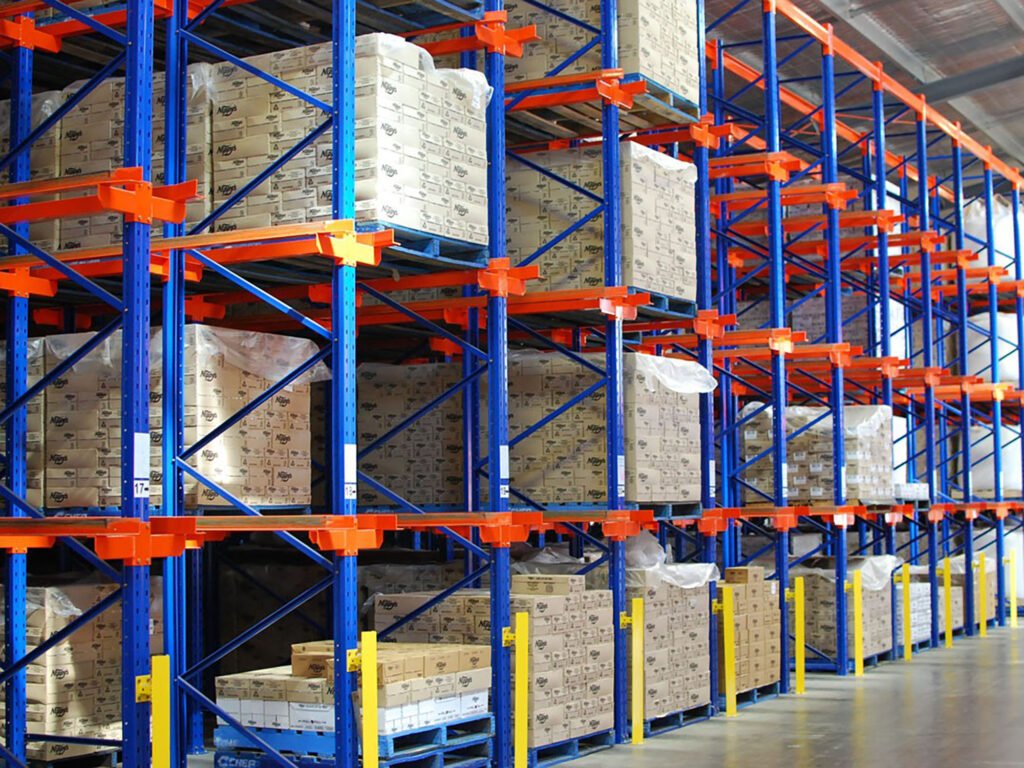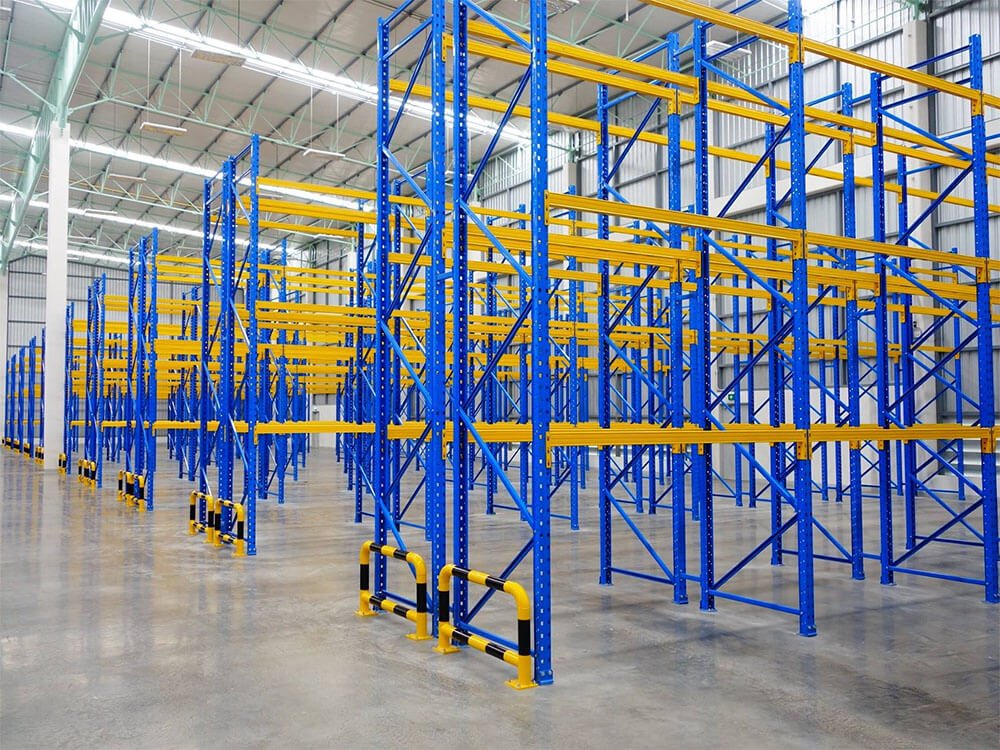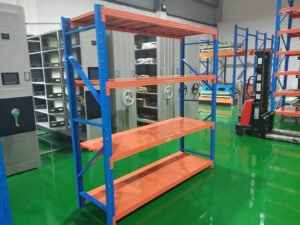Standard pallet racking systems are the main means of storing palletized goods and are essential to effective warehouse management. Although it’s critical to develop standard warehouse racking dimensions that meet your unique requirements, the task is not so easy!
There are many reasons to explain this difficulty. One of them is that pallet racking systems come in a wide range of sizes and capacities, which can lead to the paradox of choice. Another aspect lies in the various factors you must consider during the process, including figuring out the optimal beam length, frame height, depth, and weight capacity.
Realizing this pain point, this guide was created to give helpful insights on standard pallet racking systems as well as how you can measure and pick the right sizes for your warehouse. After reading, you can confidently implement the ideal solution in no time!
What Are The Standard Pallet Racking Dimensions?
To maximize space utilization and guarantee easy inventory access, warehouse managers often rely on standard pallet racking systems, which utilize both horizontal and vertical racking structures to hold pallets. Oftentimes, forklifts help move pallets on and off racks to accommodate various demands for storage and retrieval.
To choose the right pallet rack type for your warehouse, the structure’s size is one of the most crucial factors. Theoretically, manufacturers can customize this aspect for you by building any size desired by customers. However, a more effective way for both parties is to establish standard warehouse racking dimensions.
Typically, one of the most popular standard pallet racking sizes is 40 inches wide by 48 inches deep. The standard pallet rack height usually ranges from 8 feet to 24 feet, depending on how tall your warehouse ceiling is and how high your forklifts can reach.
However, here’s the tricky part. Instead of one, there are actually multiple standard pallet racking dimensions. This is fairly simple to understand, as it’s impossible to have a universal size that can satisfy all storage demands. As a result, you now face another problem: how to pick the right standard pallet racking sizes.
In addition to the structure’s dimensions, there are many other important variables, such as the rack’s load capacity, pallet quantity, and the pallet’s weight. Without careful assessment, you may overload your racking system, which can lead to many undesirable consequences for both your employees and stored products.

In-Depth Guide To Pick The Right Standard Pallet Racking Sizes
As mentioned above, figuring out the appropriate standard pallet racking dimensions is pretty challenging and time-consuming. Yet, with the following step-by-step tutorial, you can effortlessly finalize your selection in no time. Let’s go over the 4-step process of choosing the perfect standard pallet racking sizes.
Step 1: Assessing Pallet Dimensions And Weight
The first and most important step in determining the standard pallet racking dimensions is to assess pallet sizes and weight. This process starts with examining your inventory demands. While typical GMA pallets are 48 inches deep and 40 inches wide, there are a wide array of other dimensions, which depend on your unique storage needs.
To decide which pallet racks to buy, let’s calculate your pallet’s average load and maximum load. Getting these inputs precisely is critical since overloading the racks can pose severe safety issues, jeopardizing the overall system’s integrity.
Additionally, to figure out your pallet weight, you need to consider a few other aspects, including the storage capacity and available space of your warehouse. This evaluation determines the pallet racking system’s ideal layout and how many pallets your facility can hold, thus guaranteeing maximum space utilization and effective inventory.
Step 2: Determining Standard Rack Depth
After your assessment of pallet sizes and weight, it’s time to decide the standard rack depth. The top three depth options nowadays are 42-inch, 48-inch, and 36-inch. Each standard rack depth meets distinct storage requirements. However, in order to pick the right option, you’ll need to consider the overhang factor.
A properly placed pallet should overhang the beams by about three inches on both sides to guarantee that the beams can support the pallet’s total weight. While wire decking aids weight distribution, its role is not to support the whole load of a pallet.
Let’s take the 48-inch deep pallets as an example. To get the required three inches of overhang on both the front and the rear, you’ll need to deduct six inches from the pallet depth, yielding a 42-inch frame depth. This makes 42-inch deep uprights the most popular option for the standard 48-inch deep pallets.
The same principle applies for other pallet types. No matter what your pallet choice is, always provide an overhang like that to figure out the optimal pallet rack depth for your structure.

Step 3: Calculating Standard Warehouse Racking Heights
Vertical storage is frequently the most cost-effective way to utilize warehouse space. The standard pallet racking heights typically vary from 8 to 24 feet, with 12 feet and 16 feet being the most popular in the industry.
To determine the standard warehouse racking height, begin by measuring your ceiling’s highest point. After having the figure, leave about 18 to 24 inches between your stored items and the ceiling or sprinklers. This clearance helps fulfill fire safety rules while also providing critical overhead space.
For example, if your warehouse ceiling is 15 feet high, you cannot employ 16-foot pallet racks, although these structures are well-suited for 20-foot ceilings. Understanding the height constraints of each warehouse is critical for the successful planning of your pallet racking solution.
It’s recommended to go as high as possible, even if it gives you more storage than you currently need. The difference in installation expenses between a 12-foot frame and a 16-foot frame is often insignificant. However, replacing a 12-foot frame with a 16-foot frame at a later time can be far more expensive.
While aiming high is desirable, avoid going too high. Consider your forklift’s maximum operating height. If your vehicles can only reach 10 feet, it’s impossible to fully use 16-foot racks until you upgrade your equipment.
Plus, housing items beyond 12 feet high may trigger high-piled storage concerns. When applying for rack permits, the local authorities will assess your fire sprinkler system and the flammability of your products, which can limit how high you can store items.
Step 4: Deciding Standard Pallet Rack Beam Lengths
The final step is about identifying standard pallet rack beam lengths for your structure. Typical beam lengths vary from 8 to 12 feet, which helps cater to different storage demands.
Among the spectrum, the 8-foot beam is the most popular option that can store up to two standard 48’’x40’’ pallets. 12-foot beams are also widely used for increasing storage capacity. They can hold three conventional pallets per beam level.
When selecting your desired beam length, keep your warehouse layout in mind, as well as the number of pallets you need at each level. The pallet weights you determined in step 1 are also critical in choosing the appropriate beam. Heavy pallets need beams with greater load capabilities to ensure maximum safety and stability.
If you want a load capacity of roughly 5,000 pounds per beam level, an 8-foot beam is usually sufficient. For lighter pallets, 12-foot beams can be a more efficient solution, providing additional storage capacity without sacrificing safety.
Load capacity is also affected by the beam’s face size, which ranges from 3 to 6 inches. For large capacity requirements, a 6-inch face size is the go-to choice. To maintain a safe and effective racking system, make sure that both the beam length and the face size fit your exact capacity needs.
| Beam Length | Beam’s Face Size | |||
| 3 inches | 4 inches | 5 inches | 6 inches | |
| 8 feet | 2,000 lbs | 4,000 lbs | 6,500 lbs | 8,000 lbs |
| 9 feet | 1,500 lbs | 3,000 lbs | 5,500 lbs | 7,500 lbs |
| 10 feet | 1,200 lbs | 2,500 lbs | 4,500 lbs | 7,000 lbs |
| 12 feet | 800 lbs | 1,800 lbs | 3,000 lbs | 5,000 lbs |
| Load capacity per beam pair | ||||
Key Points To Consider For Your Standard Pallet Racking System
The 4-step guide above can help you determine the basic dimensions of your pallet racks. However, there are a few other aspects that influence your choice of standard pallet racking sizes. This part will walk you through all these key points.
Ensuring Proper Clearances Among Racks
Keeping appropriate spacing among racks is essential to the safety and efficiency of any inventory system. It’s a must to maintain minimum clearances among racks and building components like walls, beams, and columns. This helps shield against possible hits, such as forklift collisions, which could result in serious damage.
Many standards, like the Australian Standards for Steel Storage Racking (AS 4084:2012), stipulate that there be a minimum of 200mm of opening among pallet racks and building elements. In the event of an earthquake or an unintentional collision, this clearance serves as a buffer to protect the building’s structural integrity and the racks.
Additionally, make sure that the distance between the top of the pallet and the load beam’s underside is at least 75mm for beams shorter than 6 meters and 100mm for beams longer than 6 meters. There should also be a minimum of 430mm of space among back-to-back rows of racks for safe and efficient warehouse operations.
Adding Extra Protection For The Racking System
If you need extra protection for your standard pallet racking system, feel free to consider the following accessories:
- Upright protectors: These devices are great ways to secure your inventory solutions from careless forklift operators and other warehouse mishaps. The best practice is to mount these guards directly on the uprights. However, it’s also possible to deploy them separately from the columns.
- Pallet supports: Oftentimes, each pallet requires a pair of pallet supports with the same depth to gain additional stability. To achieve this, these supports are often placed in the pallets’ lower sections.
- Floor shims: To help level the racks and prevent them from swaying, these metal shims are positioned beneath the upright plates. These accessories play a special role when your warehouse floor is skewed and uneven.
- Safety netting: This part offers additional protection for your pallet racking systems on all of their levels by stopping items from falling from the structures. Most safety netting types are composed of nylon or polypropylene.
- Wall ties and row spacers: Pallet racks are held firmly in place at predefined distances from warehouse walls or other racking rows by wall ties and row spacers. When the upright height is greater than six times the depth of a racking row, row spacers must be placed on the top and bottom sections of each upright.
Installing Pallet Rack Decking
Besides the above accessories for extra protection, you can consider installing pallet rack decking for your inventory structure to support loads of varying sizes and weights. The following is a list of popular options you can consider for this element:
- Wire mesh: By far, wire mesh is considered the most affordable decking material out there. It is put on the beams, covering the whole rack length and offering you clear visibility of your inventory. Aside from being non-flammable, wire mesh provides a typical weight capacity of about 1,000 kg.
- Bar grating: To store huge amounts of products, you’ll need a strong material like bar grating. Despite being rather pricey, this decking option is very robust, easy to clean, and can handle practically any load requirement.
- Perforated steel: Often constructed with multiple welded supports, this decking material offers a vast level surface to house your stored items. Additionally, perforated steel is designed with holes that allow water to flow through, thereby increasing fire safety.
- Corrugated steel: Similar to perforated steel and wire mesh, corrugated steel also enables water to flow through, making it a popular decking choice. Also known as punch decks, pallet racks made of this material have substantial load capacity.
- Plywood: This decking option is good for storing lightweight items. Yet, if you’re holding heavier products, let’s choose more robust materials. Plus, plywood may cause fire safety concerns due to its flammability.
Deciding Pallet Rack Configurations
Aside from racking accessories and decking materials, deciding the right pallet rack configuration is also vital for warehouse operations. Knowing the following rack types can help you pick the standard pallet racking dimensions more easily.
- Selective racks: With horizontal beams and vertical uprights connected together, selective racks are the most widely used configuration on the market. They have open designs that offer superior access to stored products.
- Push-back racks: If you need high-density storage in a LIFO arrangement, look no further than push-back racks. In this structure, each pallet is put on a trolley or cart. When a new pallet enters the rack, it will push other pallets back to the rear of the structure.
- Drive-in racks: These inventory systems enable forklifts to move inside safely to load and unload products. Like push-back racks, drive-in racking also utilize the LIFO approach and help optimize the warehouse’s ground space.
- Adjustable racks: Standard adjustable pallet racking not only supports a wide range of pallet sizes but also offers maximum flexibility. You can easily raise or lower beams, as well as change rack depths to suit the constantly changing warehouse demands.
- Drive-thru racks: If drive-in racks are appropriate for the LIFO methodology, drive-thru systems are more suited to the FIFO approach since they have two separate entrances. Forklifts can enter the systems from one end and leave via the other end with ease.
- Pallet flow racks: These inventory solutions use inclined rollers or wheels to transport pallets from the back to the front aisles. They support the FIFO system, which means that when the front pallet is removed, the next pallet immediately slides into the place to increase picking efficiency.

42-Inch Vs 48-Inch Deep Uprights: Which Is Better?
As you know, besides the 48-inch option, there are many other pallet racking depths to choose from. Among these alternatives, the 42-inch depth is properly the most preferred solution. So, which one should you choose? Before assessing these options, let’s first address one important terminology.
Pallet Rack Flue Spaces
These gaps are vertical openings within a standard pallet racking system that are crucial for fire safety. They function similarly to a fireplace flue, allowing heat and smoke to ascend and efficiently activating fire suppression sprinkler systems. These openings also enable water to permeate stored items and extinguish flames at the source.
There are two primary types of pallet rack flue spaces: longitudinal and transverse. Longitudinal flue spaces exist between back-to-back rows of pallet racks, preventing pallets from blocking the area and allowing for effective fire suppression.
On the other hand, transverse flue spaces are the openings between the pallet load and the upright structure of the rack. These gaps must be at least 6 inches wide to meet fire safety standards. Keeping these spaces clear allows for improved fire detection, faster suppression, and minimizes horizontal fire spread.
These gaps are the key to helping you distinguish between 42-inch and 48-inch deep uprights. Now that you clearly know these gaps, let’s head for the ultimate comparison below.
42-Inch Deep Uprights
This upright type is a common option in many warehouse configurations. 42-inch deep uprights not only make it simpler for forklift operators to attach pallets to the front and back beams but also minimize the quantity of steel needed, thus resulting in lower total overall expenses.
Despite their financial advantage, 42-inch deep uprights need careful planning to maintain open flue spaces for fire protection. Also, if the frames surpass 20 feet in height, they will need specific base plates or anchors for extra stability, as the height-to-depth ratio then is higher than the 6:1 recommendation.
PROs:
- Reducing steel use.
- Arranging pallets becoming easier and safer with forklifts.
- Lowering the initial investment.
CONs:
- More challenging to maintain open flue spaces.
- Requiring extra components for heights greater than 20 feet.
48-Inch Deep Uprights
Unlike their counterparts, 48-inch deep uprights offer a more sturdy inventory option. They bring about increased safety for ground-level picking, particularly when combined with wire decking. Moreover, these frames facilitate open flue spaces, resulting in neater aisles with no pallet overhang.
While demanding more steel and having a greater initial cost, they provide substantial benefits in terms of ease of use and stability. The exact alignment of beams supports both the front and back of pallets, thus lowering the margin for error during forklift operation.
PROs:
- Easy to maintain open flue spaces.
- Offering neater aisles with no pallet overhang.
- Safer for ground-level picking.
CON:
- Using more steel, making it more expensive.
- Requiring precision forklift loading.
Conclusion
To sum up, by choosing the ideal standard pallet racking system, you can easily improve storage capacity and warehouse safety. A suitable inventory solution also leads to effective warehouse operations and meets your changing demands via a high level of customization.
To have the right pick, you’ll need to thoroughly understand the standard warehouse racking dimensions and carefully consider pallet sizes, weights, and the necessary clearances. It’s also important to choose the appropriate configurations and include extra protection measures.
The guide in question contains everything you need to know about standard pallet racking systems, from what they are to how you should implement them. The guide also delves into the comparison between 42-inch and 48-inch deep uprights, which further deepens your knowledge about the topic. Thanks for reading!




